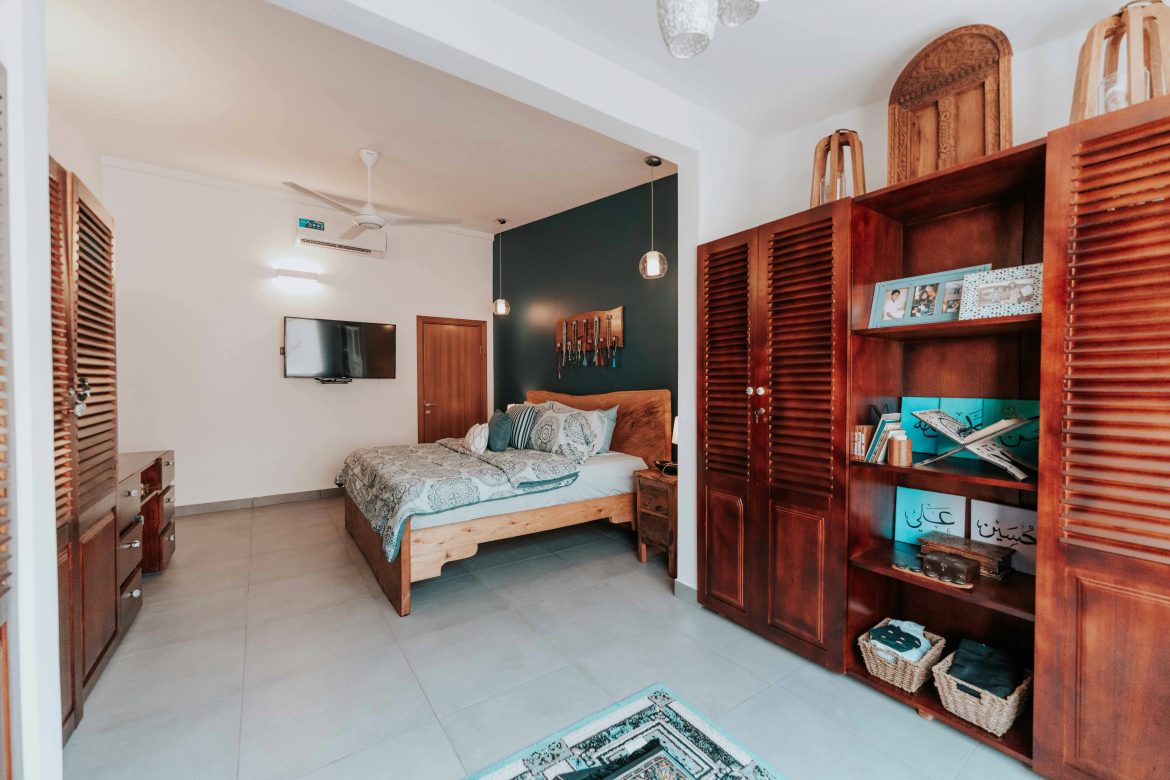Dividing a bedroom into two spaces — whether to create a private corner, a work nook, or a dressing area — doesn’t always mean knocking down walls or starting a renovation. With a little creativity and the right layout, it’s possible to introduce subtle separation while maintaining a sense of calm and cohesion.
From soft textile solutions to clever furniture placement, these versatile ideas allow for dual-purpose bedrooms that are as functional as they are beautiful.
ALSO SEE: How to use fragrance as home decor
Create soft separation with fabric
When walls aren’t an option, curtains or drapery offer one of the simplest and most flexible solutions. A full-length curtain hung across a doorway, around a bed, or in front of an alcove can create an instant retreat. It brings a softness to the room while offering privacy when needed. When drawn back, it keeps the space open and filled with light — perfect for smaller bedrooms or shared spaces.
Use a half-wall as a subtle boundary
Installing a stud wall — either floor-to-ceiling or partial height — is a more permanent way to divide a room without losing openness. Placed behind a bed, it can act as both a headboard and a divider, separating a sleep zone from a dressing area or workspace. It can also double as a feature element when painted or wallpapered in a contrasting tone, creating visual interest and spatial clarity.
Build the bed into a nook
Designing a bed within a niche, or building one into an alcove, can help define a sleeping zone and make the most of awkward layouts. Tucking the bed into a corner and framing it with shelves, a raised platform or even simple curtains transforms it into a cosy cocoon — ideal for rooms that need to serve multiple purposes. This setup maximises floor space while giving the sleeping area a clear sense of place.
Rethink your furniture layout
Sometimes, a room doesn’t need to be physically divided — it simply needs to feel divided. Clever styling and considered placement of furniture can help define areas for sleeping, dressing, or working. Positioning a chair, small table, or open shelving unit between zones creates natural pauses in the room’s flow, helping each area feel intentional. It’s a subtle, space-saving way to create distinction without changing the structure of the room.
Use low-profile furniture to mark zones
Tall wardrobes or partitions aren’t always necessary. A chest of drawers, low bookcase or bench can act as a gentle visual divider between one part of the room and another. These pieces add storage while creating a sense of boundary, making each area feel like its own functional space. Choosing furniture with a flat back allows for placement in the centre of a room without disrupting flow or sight lines.
Add internal glass to separate while keeping light
If you’re open to structural changes, glass partitions offer a stylish way to create division while allowing natural light to flow through. Framed internal windows or glass doors lend a sleek, contemporary feel, while maintaining openness. Ideal for dividing sleeping areas from dressing spaces or en suites, glass walls allow privacy without making the room feel closed off.
Build a permanent wall — when it makes sense
Sometimes, the best option really is to build a solid wall. Whether you’re creating two bedrooms out of one or separating an office space from a rest area, a wall offers maximum privacy, sound control and functionality. Once in place, each area can be styled to reflect its purpose, making both spaces feel complete.
Position tall storage as a dividing tool
A wardrobe or armoire can act as both a functional storage piece and a smart room divider. By placing it strategically — between two beds, or between the sleep area and a reading nook — you carve out separate zones without any building work. For best effect, use pieces that are accessible from both sides or combine with open shelving to avoid cutting off too much light.
Create a compact workspace that’s tucked away
With remote work becoming part of everyday life, carving out a small home office within the bedroom is increasingly common. To keep things feeling calm, it helps to contain the workspace with visual cues. A simple curtain, shelving frame, or difference in colour tone can distinguish the work area from the rest zone. By keeping the styling consistent but purposeful, both areas can coexist peacefully.
Use a freestanding screen for instant division
A folding screen is one of the easiest ways to divide a room without commitment. Lightweight, movable and decorative, a screen can instantly create a visual barrier between zones. Whether it’s placed to section off a study area, split twin beds, or provide dressing privacy, it allows the space to flex with your needs. And when it’s no longer required, it can be folded away or moved elsewhere with ease.
Design with intention, not disruption
Dividing a bedroom doesn’t have to mean compromising style. With thoughtful design choices and layered solutions, it’s possible to create distinct zones while keeping the room cohesive and elegant. Whether you’re sharing a room, working from home, or simply want to zone off a quiet corner, these smart design strategies allow your space to work harder — without ever feeling cluttered or closed in.
ALSO SEE:
Timeless interior decorating tips we should steal from our parents and grandparents
Featured Image: Pexels

